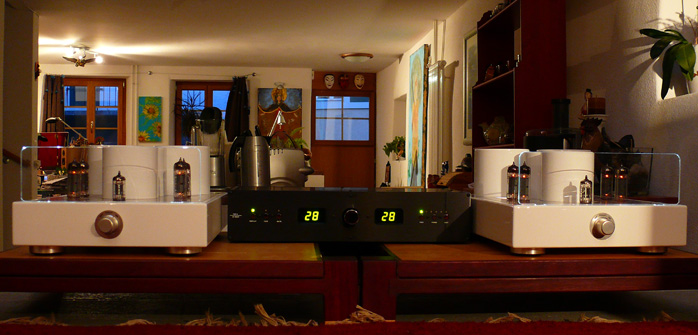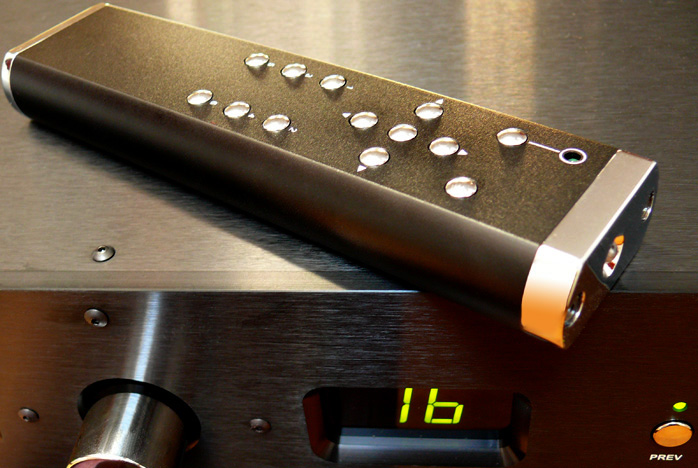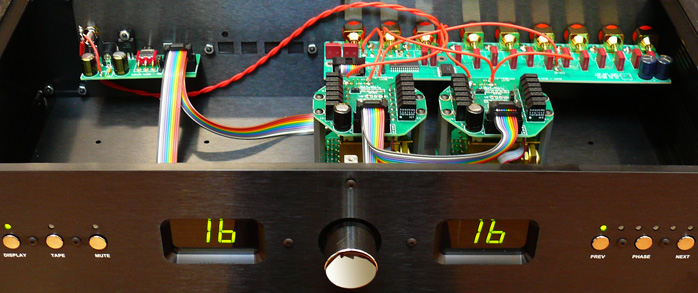This review page is supported in part by the sponsors whose ad banners are displayed below |
 |
Spreading the luv interlude: During my visit with the three Grande Castine hornspeaker principals in Chateaubernard of France's Cognac region chronicled here, I'd listened to a prototype EL-156 SET built by Dominique Mafrand, a high-end retailer who crafts custom low-power triode amps for his clients. This amp omits the usual tube driver in favor of passive voltage gain. The entire signal path consists of a stepup transformer, one EL-156 per side strapped to triode and the output transformer. I'd suggested to the gents that if their output transformer wasn't yet locked in, they might want to commission Sasa for a sample to compare to their current contestants. Dominique copied me on his email to Sasa a few weeks later: "Well, regarding your output transformers, we installed them, listened for 30 seconds and ... adopted them! Great sound, relaxed, detailed, full-bodied, airy - exactly what we were looking for. Thanks for the great job. We are now thinking about the amplifier enclosure and will be back at you for purchasing. We keep in touch."
Having discovered Sasa Cokic still prior to his reputation spreading outside Serbia, I now took pleasure seeing his transformer design talent acknowledged by other amp crafters. It's recently even spread to South Korea. Now back to the Kaivalya.
|
|
|
 |
Positive feedback: When Inès Adler dropped off her Voxativ Ampeggio to check out my setup and available amplifiers before committing to the assignment, I played her all FirstWatt amplifiers then on hand—F5, J2, M2—my Yamamoto A-09S SET with six different output bottles—EML 300B XLS, EAT, WE, Shuguang Black Treasure, TJ Full Music SE, Synergy Hifi—and the Kaivalyas. We both agreed that the Serbians made for the ultimate combination with these 98dB single-driver widebanders. That's how the majority of that review was conducted. Inès was so impressed with the white amps in fact that she immediately contacted Sasa to inquire about future cooperation potential between their two firms. Whether anything comes of it I don't know but it was still a very gratifying early Kaivalya response from a visiting manufacturer. Had my speaker loaners been in white piano lacquer, the cosmetics with the Kaivalyas would have been over the top.
|
 |
Negative feedback: "One trick I haven't seen used or read about elsewhere is my very low local feedback loop between driver stage and the input of the output stage through the interstage transformer. I use just 0.3dB. It would appear to be entirely inconsequential. However, it very strategically eliminated 30% of predominantly 2nd-order THD from the 12AU7 driver. That's huge and sonically very decisive. The second local feedback loop is between the EL84s and speaker terminals through the OPT. That's 4dB. While the overall circuit is unconditionally stable without any feedback, this loop too controls THD for the intended final sound. I would never consider global overall feedback but for this project, the two nested loops became very important for the sound we were after."
|
|
|
Sasa's explanation became perfectly predictive towards actual sonics. Compared to my Yamamoto which I and others think of as a spiritual heir to Western Electric's movie-house amplifier ideal, the Kaivalyas—take your pick—exorcise or discipline much of the THD fingerprint one associates with zero NFB triodes. What remains is still more/different than my FirstWatt transistors but far closer to them. I already said that living with the F5 and J2 had over time alienated me from enjoying the typical 2nd-order coagulation effects of the Yamamoto. Those compound with the more complex music I fancy. Hence I was thrilled by this textural thinning leading to energetic quickening.
|
 |
What had eventually turned tables back on the Yamamoto was its creator's dispatch of a passive volume controller. Caricatured as "lean, mean and straight to the bean" in my review, it had acted like a turbo boost, cobweb remover or blood thinner. It had also dissolved innate electronic tension. This created a nearly limpid floating space on which tone colors could freely spread. While the passive did not wholesale eliminate specific SET limitations—very low-volume listening sessions and massive symphonic were still better served by the transistors—it quite resolutely shifted the balance in favor of the power triodes. I once again loved them for where they excel. The Ampeggio encounter was sublime and a nearly idealized perfect match. As such I've signed on to review Voxativ's top-line model with field-coil motor when it launches (ideally in white lacquer to cosmetically marry the Kaivalyas).
|
 |
What I own is no high-impedance 98dB widebander of course. It's a 91dB 5-driver 3-way with exceptional bass extension. Still, the passive+Yamamoto fling had reminded me. Such combos can work exceptionally well if one keeps the passive-to-amp interconnect short. I just had to try that on the Kaivalyas. During these experiments I eventually eliminated even the passive to drive the amps straight off my Weiss Firewire DAC2. Its output voltage can be resistively trimmed from 5.48 to 2.74, 1.78 or 1.35V. This analog provision adapts the DAC to an amp's input sensitivity (3V in this case). I set the Weiss to 2.74V, then trimmed the desired listening level in the digital domain by activating its variable mode. [Above - the two lit right controls become volume up/down.]
This teleported me right back into Yamamoto/Voxativ milieu. While tone colors weren't quite as intense and the gestalt less billowy, bass was more potent and extended, the power zone had clearly more kick and the uppermost harmonics were more Platinum. The extent to which lateral space lit up to illuminate everything as though clouds parted was quite uncanny. Eliminating first active preamp circuitry even in no-gain mode (Esoteric C-03), then a purist passive with short top-class Stealth Indra interconnects (Yamamoto AT-03-1A) to finally driving a 4-meter cable source direct (DAC2) became a progression in stages. It proceeded from relative laziness, thickness and opacity to tacit directness and luminosity. The 'no preamp is the best preamp' motto is far from universal. In this instance it simply applied. Whatever theoretical losses very mild digital attenuation incurred were more than offset by analog losses in resistive volume controls, active circuitry and additional cables.
|
|
|
This compelled me to reinvestigate passives. Wanting remote volume and balance control, the ability to drive long interconnects and no drive loss at very low levels, I contacted John Chapman of Bent Audio. He had sadly discontinued his Tap-X autoformer preamp to not compete with OEMs who source from him various resistor- or AVC-based attenuation modules with integral remote control. Luckily John had a trade-in unit. Until Sasa authored his own White Range preamp, I needed a no-preamp preamp to maximize my new monos.
|
 |
While the Tap-X has turned unobtainium—or green for envy—save for the second-hand market, its truly brilliant execution still merits brief commentary.
|
 |
The remote control is a piece of art. Besides switching inputs, volume and balance, it also affords mute and display off.
|
 |
The autoformers are very tidy to keep the actual signal path wiring short. The red flying leads handle input switching commands, the power board supplies the display and relay activation.
|
 |
The switching units are top-quality hermetically sealed Pickering reed relays usually only seen in instrumentation and automated test equipment applications.
|
 |
 |
Compared to the CND $8.499 Avtac Pasiphae with its Nixie tube display [left], the Tap-X trades an overbuilt chassis, XLR i/o paths and the Pasiphae's 24-step Stevens & Billington transformer modules for 61-step Slageformers in 1dB increments. At $2.000 when new and available, the Tap-X most decidedly was one of the unsung overachievers and true values in this sector. I'm thrilled to have secured a rare straggler after the fact as it were. The new Audience Wavemaster preamp seems based on the same Slagleformer modules albeit with custom wiring, then adds a proprietary buffer plus headphone output. If one disregards the small matter of the Wavemaster's anticipated $12.000 sticker, not all is thus lost on this front. |
|
  |
 |
|